Wrapping Up 2024: A Boost for Children’s Book Authors

As the year draws to a close, it’s the perfect moment to reflect and recharge for what’s ahead. To truly stand out in 2025, let’s explore some bold and fresh approaches to your work—ideas that aren’t just new but will set your stories apart.
Consider Interactive Storytelling
How can your stories help children engage with the world you’re creating? Consider designing narratives where young readers can shape the outcome, making choices that drive the story forward. Consider a book that adapts to their curiosity, enhanced with QR codes leading to audio tracks, animations, or activities. Your illustrations might hold puzzles or hidden clues that enrich the narrative. Adding interactivity can transform your books into cherished adventures.
Let Characters Shape the Plot (Not the Other Way Around)
Start with a character who defies expectations. For example, a shy kid who spends their days studying insects becomes the unlikely hero when the town faces an invasion of magical fireflies. Or imagine an old cat who teams up with a goldfish to solve a neighborhood mystery. Let their quirks and personality lead the story rather than forcing them into a pre-planned plot. This approach can result in unpredictable stories that feel alive.
Use Sensory Details for Better Learning
Sensory details are an essential part of early childhood development, helping children engage with the world through touch, sight, and sound. Smooth wooden pieces, velcro tabs, and fabric pockets offer tactile stimulation, while bold colors and contrasting patterns capture their visual attention. These interactions support fine motor skills, focus, and problem-solving abilities as children explore and make connections.
Silent books are one great example that utilize these sensory elements effectively. A page might feature a fuzzy animal, a shiny reflective mirror, or a series of buttons to press and move. These interactive, wordless books encourage children to interpret stories through sensory exploration, sparking creativity and enhancing both cognitive and sensory growth.
Rethink the Villain
Villains don’t always have to be traditional “bad guys.” Sometimes, the antagonist can be a real character with a different perspective or misunderstood motives. For example, a grumpy park ranger might appear to be the villain, but he’s simply trying to protect an endangered species from well-meaning but careless children. Similarly, a robot programmed to maintain cleanliness might seem like the antagonist, but its strict adherence to rules creates problems for others.
These types of layered characters help teach empathy, as they show that even those in opposition to the hero often have valid reasons for their actions. This approach encourages young readers to see things from multiple viewpoints and understand that not everything is as it first appears.
Ask, “What Would a Kid Do?”
When you’re stuck, try thinking from a child’s perspective. If a group of kids stumbled upon a treasure map, they might prioritize finding snacks for the journey over strategizing about the treasure. Or in a spooky forest, they’d likely make a game out of jumping over roots instead of worrying about what lurks in the shadows. Centering their viewpoint creates stories that feel authentic and relatable.
Use Unlikely Pairings
Combine two ideas that seem like they don’t belong together. For example, imagine a pirate who’s terrified of water but insists on finding a hidden underwater treasure. These pairings create humorous and heartfelt moments that keep readers hooked.
Borrow From Science (and Make It Wild)
What if you turned a fun fact into a story? For instance, a penguin who can’t seem to stay warm no matter how many layers of feathers it grows. In its quest to find the perfect warmth, the penguin discovers how different animals in cold environments have adapted to survive. This story could introduce readers to the science of animal adaptations while following the penguin’s journey to understand how it fits into the natural world. Using real scientific facts as the foundation for a story can not only make learning fun but also offer an opportunity to explore interesting concepts in a memorable way.
Use the “What If?” Trick
The simplest way to spark an idea is to ask, “What if?” What if toys came alive when no one was looking, but they were really bad at staying hidden? What if a child’s drawings started appearing in real life? What if a kid discovered they could turn invisible—but only when they were feeling embarrassed? This question opens up endless possibilities and ensures your stories feel fresh and full of wonder.
Celebrate Imperfection
Show kids that it’s okay to be imperfect. By highlighting characters who struggle but ultimately find success through their mistakes, you can teach valuable lessons about resilience and self-acceptance. These stories encourage children to embrace their flaws and understand that growth often comes from failure, offering inspiration and a deeper sense of confidence.




